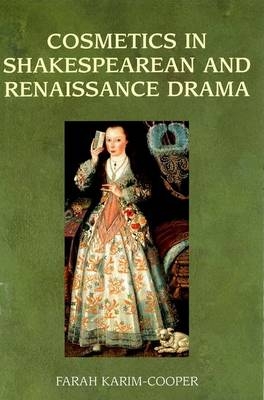
Cosmetics in Shakespearean and Renaissance Drama
Edinburgh University Press (Verlag)
978-0-7486-1993-1 (ISBN)
- Titel ist leider vergriffen;
keine Neuauflage - Artikel merken
This original study examines how the plays of Shakespeare and his contemporaries dramatise the cultural preoccupation with cosmetics. Farah Karim-Cooper analyses contemporary tracts that address the then contentious issue of cosmetic practice and identifies a 'culture of cosmetics', which finds its visual identity on the Renaissance stage. She also examines cosmetic recipes and their relationship to drama as well as to the construction of early modern identities. Cosmetics in Shakespearean and Renaissance Drama * is the only in-depth study of cosmetic culture and its visual representation on the Renaissance stage * provides original views of Shakespearean and Renaissance drama by examining its preoccupation with cosmetic ingredients, metaphors and the staging of painted beauty * offers insight into Renaissance women's cosmetic practice by uncovering a wide range of ingredients, methods and materials used in the construction of cosmetics * includes numerous cosmetic recipes found in early modern printed books, never before published in a modern edition.
Farah Karim-Cooper is the Globe Education Lecturer at Shakespeare's Globe and Visiting Research Fellow of King's College, London. Her research interests lie generally in the field of Renaissance drama and culture, and specifically, in material culture.
Acknowledgements; List of Illustrations; Chapter 1: Defining Beauty in Renaissance Culture; I. 'Beauty's red and virtue's white': Treatises on Beauty; II. The Poetry of Love, Beauty and Courtship; III. Beauty in Pictures: Plays and Emblem Books; Chapter 2: Early Modern Cosmetic Culture; I. 'The Devil's craft': The Opposition to Cosmetics; II. 'She Shal Appeare to be the Age of Fifteene Yeares'; III. Painting the Queen; Chapter 3: Cosmetic Restoration in Jacobean Tragedy; I. 'The artificial shine': Painted Language; II. Cosmetic Revenge Tragedy; III. 'Dainty preserved flesh': Fetishising the Painted Body; IV. Catholic Ritual and Cosmetics; Chapter 4: John Webster and the Culture of Cosmetics; I. Beautified and Heroic: Webster's Painted Ladies; II. Rethinking Webster's Imagery; A. Cosmetics and Catholic Imagery; B. Cosmetics and Witchcraft; Chapter 5: Jonson's Cosmetic Ritual; I. 'Pieced Beauty': Cosmetics as Prosthetics; II. Constructing Gender in Jonsonian Comedy; III. Jonson and the Cosmetics Debate; Chapter 6: Cosmetics and Poetics in Shakespearean Comedy; I. Painting Players; II. Beautifying Poetic Drama; Chapter 7: 'Deceived with ornament': Shakespeare's Venice; I. Cosmetic Materials in The Merchant of Venice; II. Cosmetic Symbolism and Othello; Chapter 8: 'Flattering Unction': Cosmetics in Hamlet; I. Appearances and Realities: Painted Faces in Hamlet; II. Mousetraps; III. Cosmeticised bodies and the female interior; A. Inside Gertrude's Closet; B. Ophelia's Beautifying Craft; Epilogue; Bibliography.
| Erscheint lt. Verlag | 6.7.2006 |
|---|---|
| Zusatzinfo | 17 black & white illustrations |
| Verlagsort | Edinburgh |
| Sprache | englisch |
| Maße | 156 x 234 mm |
| Gewicht | 560 g |
| Themenwelt | Kunst / Musik / Theater ► Theater / Ballett |
| Sachbuch/Ratgeber ► Gesundheit / Leben / Psychologie ► Schönheit / Kosmetik | |
| ISBN-10 | 0-7486-1993-3 / 0748619933 |
| ISBN-13 | 978-0-7486-1993-1 / 9780748619931 |
| Zustand | Neuware |
| Haben Sie eine Frage zum Produkt? |
aus dem Bereich


